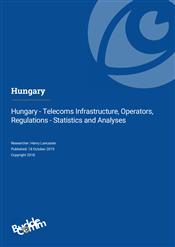Hungary - Telecoms Infrastructure, Operators, Regulations - Statistics and Analyses

Last updated: 18 Oct 2019 Update History
Report Status: Archived
Report Pages: 79
Analyst: Henry Lancaster
Synopsis
As in many other markets in the region, in Hungary the number of fixed-lines, as also fixed-line revenue, has been affected by the changing consumer use of such services and by the trend for fixed-to-mobile substitution. Fixed-line operators have thus looked to fixed and mobile broadband services to boost revenue and have promoted bundled services offerings in a bid to attract and retain customers. Pursuing this strategy formed part of the reasoning behind Vodafone Group’s mid-2019 acquisition of UPC Hungary.
The economic crisis of a decade ago also affected telecom revenue, though recovery since 2013 has improved disposable income among consumers and so helped revitalise sector revenue. However, financial recovery among telcos has been rendered more difficult by the government’s telecom and utility taxes, as also by regulated measures on termination rates and roaming charges.
The government has struck deals with Maygar Telekom and a number of other operators under which the telcos are extending super-fast broadband access to underserved areas. For its part, the government agreed not to provide funding to competitors in specific areas where telcos undertook to provide network upgrades. Hungary now has one of the most developed telecom infrastructures in the region. Services based on 5G are anticipated shortly after the multi-spectrum auction to be held in November 2019, while the incumbent telco, which already provides a gigabit service to over a third of premises, is fast replacing its legacy copper networks with fibre.
This report provides an overview of Hungary’s telecoms market, highlighting regulatory developments, the major operators, fixed-line network infrastructure and a variety of statistics.
Key developments:
- Amendments to Utility Tax encouraging operators to accelerate deployment of superfast broadband networks;
- Government scraps proposed levy on internet traffic, continues with other telecom taxes;
- Amended access regulations incorporate fibre and cable infrastructure sharing;
- Report update includes the regulator's market data to June 2019, telcos' financial and operating data for Q2 2019, Telecom Maturity Index charts and analyses, recent market developments.
Companies covered in this report include:
Magyar Telekom, Invitel, Antenna Hungaria, GTS-Datanet, B2B Europe
Related Reports
- Hungary - Telecoms, Mobile and Broadband - Statistics and Analyses
- Europe - Mobile Network Operators and MVNOs
- Luxembourg - Telecoms, Mobile and Broadband - Statistics and Analyses
- Montenegro - Telecoms, Mobile and Broadband - Statistics and Analyses
- Denmark - Telecoms, Mobile and Broadband - Statistics and Analyses
- Czech Republic - Telecoms, Mobile and Broadband - Statistics and Analyses
- Greece - Telecoms, Mobile and Broadband - Statistics and Analyses
- Cyprus - Telecoms, Mobile and Broadband - Statistics and Analyses
- Belarus - Telecoms, Mobile and Broadband - Statistics and Analyses
- Austria - Telecoms, Mobile and Broadband - Statistics and Analyses
Share this Report
TMT Intelligence
A platform to scale your intelligence tasks
Monitor critical insights with our AI-powered Market Intelligence Platform gathering and analyzing intelligence in real time. With AI trained to spot emerging trends and detect new strategic opportunities, our clients use TMT Intelligence to accelerate their growth.
If you want to know more about it, please see:
Research Methodology
BuddeComm's strategic business reports contain a combination of both primary and secondary research statistics, analyses written by our senior analysts supported by a network of experts, industry contacts and researchers from around the world as well as our own scenario forecasts.
For more details, please see:
More than 4,000 customers from 140 countries utilise BuddeComm Research
Are you interested in BuddeComm's Custom Research Service?
Hot Topics
News & Views
Have the latest telecommunications industry news delivered to your inbox by subscribing to BuddeComm's weekly newsletter.